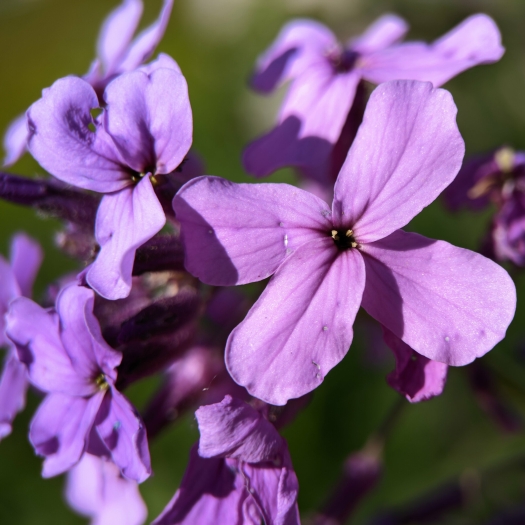Dame’s Rocket
(Hesperis matronalis)
Dame’s Rocket (Hesperis matronalis)
/
/

© Stephan Mende
CC BY 4.0
Image By:
© Stephan Mende
Recorded By:
Copyright:
CC BY 4.0
Copyright Notice:
Photo by: © Stephan Mende | License Type: CC BY 4.0 | License URL: http://creativecommons.org/licenses/by/4.0/ | Uploader: grid33 | Publisher: iNaturalist |
























Estimated Native Range
Summary
Hesperis matronalis, commonly known as Dame’s Rocket or Sweet Rocket, is a biennial or short-lived perennial herb native to open woodlands and forest edges in Eurasia. It typically grows up to 3 feet tall and features lance-shaped leaves. The plant produces clusters of fragrant flowers in shades of lavender, purple, pink, or white from late spring to early summer, which are highly attractive to pollinators such as bees and butterflies. The flowers are showy and make a striking display when planted en masse.
Dame’s Rocket is valued for its sweetly scented flowers and its ability to naturalize in garden settings. It is often used in cottage gardens, wildflower meadows, and as a border plant. While it prefers moist, well-drained soil, it is quite adaptable and can tolerate a range of soil conditions. It thrives in full sun to partial shade and requires moderate watering. However, gardeners should be cautious as Hesperis matronalis can become invasive outside its native range, spreading by seed and outcompeting native flora. It is considered a noxious weed in some regions, so it is essential to check local regulations before planting.CC BY-SA 4.0
Dame’s Rocket is valued for its sweetly scented flowers and its ability to naturalize in garden settings. It is often used in cottage gardens, wildflower meadows, and as a border plant. While it prefers moist, well-drained soil, it is quite adaptable and can tolerate a range of soil conditions. It thrives in full sun to partial shade and requires moderate watering. However, gardeners should be cautious as Hesperis matronalis can become invasive outside its native range, spreading by seed and outcompeting native flora. It is considered a noxious weed in some regions, so it is essential to check local regulations before planting.CC BY-SA 4.0
Plant Description
- Plant Type: Herb
- Height: 1-3 feet
- Width: 1-2 feet
- Growth Rate: Rapid, Moderate
- Flower Color: Pink, Purple, White
- Flowering Season: Spring, Summer
- Leaf Retention: Deciduous
Growth Requirements
- Sun: Full Sun, Part Shade
- Water: Medium
- Drainage: Medium, Slow
Common Uses
Bee Garden, Border Plant, Butterfly Garden, Fragrant, Low Maintenance
Natural Habitat
Open woodlands and forest edges in Eurasia
Other Names
Common Names: Night-scented Gilliflower , Sweet Rocket , Dame’s-Violet , Queen’s Gilliflower , Mother-of-the-evening , Damask-Violet
Scientific Names: Hesperis matronalis , Hesperis adenosepala , Hesperis adenosepala , Hesperis alba , Hesperis candida , Hesperis cilicica , Hesperis cilicica , Hesperis matronalis subsp. candida , Hesperis matronalis subsp. sibirica , Hesperis matronalis var. hortensis
GBIF Accepted Name: